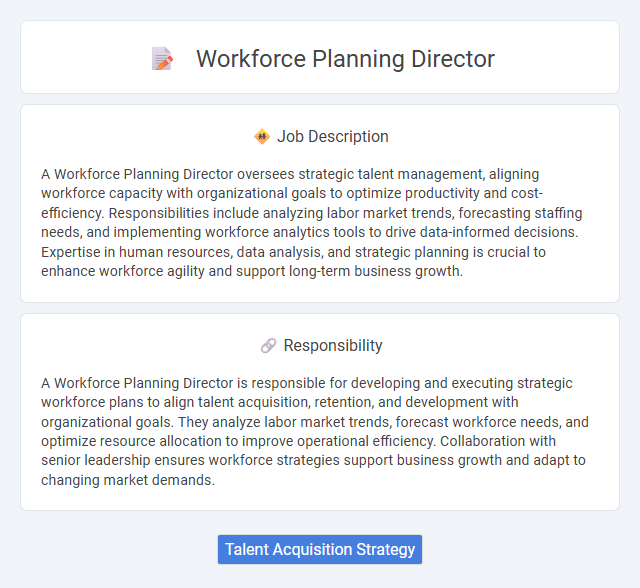
A Workforce Planning Director oversees strategic talent management, aligning workforce capacity with organizational goals to optimize productivity and cost-efficiency. Responsibilities include analyzing labor market trends, forecasting staffing needs, and implementing workforce analytics tools to drive data-informed decisions. Expertise in human resources, data analysis, and strategic planning is crucial to enhance workforce agility and support long-term business growth.
Individuals with strong analytical skills and a strategic mindset are likely to be well-suited for a Workforce Planning Director role, as the position demands the ability to forecast labor needs and align talent management with business goals. Those who thrive under pressure and possess excellent communication skills may have a higher probability of success, given the requirement to collaborate across departments and influence decision-making at senior levels. Conversely, candidates lacking adaptability or a keen understanding of workforce dynamics might find this role challenging.
Qualification
A Workforce Planning Director must possess advanced expertise in human resources management, data analytics, and strategic workforce forecasting. Typically, candidates hold a bachelor's or master's degree in business administration, human resources, or industrial-organizational psychology, complemented by certifications such as SHRM-SCP or CIPD. Proven experience in leading workforce analytics, demand planning, and talent optimization initiatives is essential for effective strategic decision-making and operational efficiency.
Responsibility
A Workforce Planning Director is responsible for developing and executing strategic workforce plans to align talent acquisition, retention, and development with organizational goals. They analyze labor market trends, forecast workforce needs, and optimize resource allocation to improve operational efficiency. Collaboration with senior leadership ensures workforce strategies support business growth and adapt to changing market demands.
Benefit
A Workforce Planning Director likely enhances organizational efficiency by accurately forecasting labor needs and aligning talent strategies with business goals. This role probably reduces costs through optimized staffing and minimizes turnover by anticipating workforce trends. Companies might experience improved productivity and agility, making the position a valuable asset for long-term success.
Challenge
Workforce planning directors likely face the challenge of accurately forecasting labor needs in an evolving business landscape marked by rapid technological change and shifting market demands. They must balance resource allocation to optimize productivity while minimizing costs, often under tight budget constraints. Managing cross-departmental collaboration and integrating data-driven insights could be crucial to overcoming these complexities effectively.
Career Advancement
A Workforce Planning Director plays a critical role in aligning talent strategies with business objectives, ensuring the efficient allocation of human resources to meet organizational goals. Career advancement in this field typically involves progressing from workforce analyst roles to senior management positions, gaining expertise in data analytics, strategic planning, and leadership. Developing skills in predictive modeling and cross-functional collaboration enhances opportunities to advance to executive roles such as VP of Workforce Strategy or Chief Human Resources Officer.
Key Terms
Talent Acquisition Strategy
The Workforce Planning Director oversees the development and execution of comprehensive talent acquisition strategies to align workforce capabilities with organizational goals. This role involves analyzing labor market trends, optimizing recruitment processes, and leveraging data-driven insights to identify skill gaps and forecast future hiring needs. By ensuring strategic workforce deployment, the director enhances organizational agility and supports sustained business growth.
 kuljobs.com
kuljobs.com